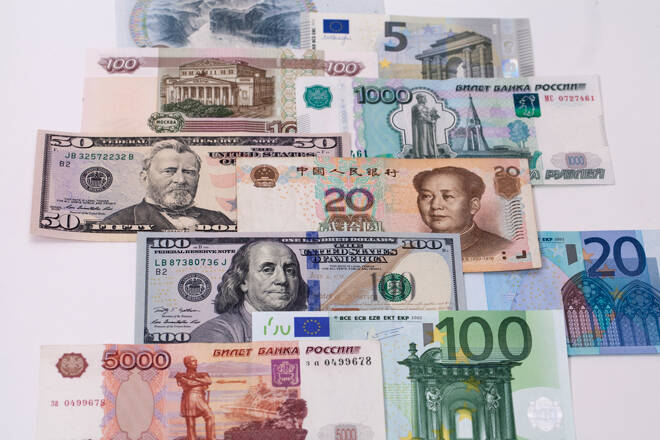Advertisement
Advertisement
Private Sector PMIs Put the GBP, the EUR, and the Greenback in Focus
By:
It's a busy day ahead on the economic calendar. Private sector PMIs from the UK, the Eurozone, and the U.S will be in focus along with Eurozone consumer confidence,
Earlier in the Day:
It was a busy start to the day on the economic calendar this morning. The Kiwi Dollar and the Japanese Yen were in action early this morning.
For the Kiwi Dollar
In the month of February, the trade balance rose from a NZ$647m deficit to a NZ$181m surplus. Year-on-year, the trade surplus narrowed from NZ$2,730m to NZ$2,360m in February.
According to NZ Stats,
- The value of goods exported fell NZ$416m compared with the same period last year.
- Exports were down to all New Zealand’s top trading partners, with the exception of China.
- To China, exports increased NZ$369m from February 2020.
- Weaker dairy sales weighed on overall exports in February.
- The value of imports fell by NZ$46m to $4.3bn in February 2021.
- Crude oil imports slid NZ$201m (80%).
- Imports of mechanical machinery and equipment were down NZ$119m.
- Imports of vehicles, parts, and accessories rose NZ$135m, however, driven by a $122m rise in motor vehicle imports.
The Kiwi Dollar moved from $0.70054 to $0.70076 upon release of the figures. At the time of writing, the Kiwi Dollar was down by 0.06% to $0.6995.
For the Japanese Yen
Private sector PMIs for March were in focus this morning.
In March, the Manufacturing PMI increased from 51.4 to 52.0, with the service PMI rising from 46.3 to 46.5.
According to the prelim March survey,
- New orders declined further, though the rate of decline was the softest in the current 14-month sequence of decline.
- New business across the services sector continued to weigh on new orders, as new orders across the manufacturing sector increased at a faster clip.
- By contrast, service sector firms reported a weaker decline in new export orders, while manufacturing sector companies reported weaker growth.
- Employment levels increased at the fastest pace since January 2020, however. The pickup in hiring was supported by optimism that private sector activity would pick up in the year-ahead.
The Japanese Yen moved from ¥108.597 to ¥108.632 upon release of the figures. At the time of writing, the Japanese Yen was up by 0.01% to ¥108.58 against the U.S Dollar.
Elsewhere
At the time of writing, the Aussie Dollar was down by 0.16% to $0.7612.
The Day Ahead:
For the EUR
It’s a busy day ahead on the economic calendar. Prelim private sector PMIs for March are due out for France, Germany, and the Eurozone.
While the focus remains on German manufacturing sector activity, the services PMIs will also draw interest.
Late in the session, flash Eurozone consumer confidence figures will also influence.
Away from the economic calendar, COVID-19 lockdown news will remain factor, however.
At the time of writing, the EUR was down by 0.03% to $1.1845.
For the Pound
It’s a relatively busy day ahead on the economic calendar. Prelim private sector PMI numbers for March are due out.
Expect the service sector figures to have the greatest impact. While the headline number is key, inflation, new business and employment will be other areas of interest.
February inflation figures are also due out but will likely take a back seat to the PMIs.
At the time of writing, the Pound was down by 0.12% to $1.3736.
Across the Pond
It’s a busy day ahead on the economic calendar. Core durable goods orders are due out along with prelim private sector PMI numbers for March.
Expect core durable goods and service sector PMI numbers to have the greatest impact on market risk sentiment.
February durable goods orders, are also due out. Barring dire numbers, however, these will likely have a muted impact on the markets.
On the monetary policy front, FED Chair Powell is scheduled to deliver a 2nd day of testimony that will also draw interest.
At the time of writing, the Dollar Spot Index was up by 0.07% to 92.399.
For the Loonie
It’s yet another quiet on the economic calendar. There are no material stats due out of Canada to provide the Loonie with direction.
The lack of stats will leave the Loonie in the hands of market risk sentiment and crude oil inventories on the day.
At the time of writing, the Loonie was up by 0.05% to C$1.2582 against the U.S Dollar.
For a look at all of today’s economic events, check out our economic calendar.
About the Author
Bob Masonauthor
With over 28 years of experience in the financial industry, Bob has worked with various global rating agencies and multinational banks. Currently he is covering currencies, commodities, alternative asset classes and global equities, focusing mostly on European and Asian markets.
Advertisement
